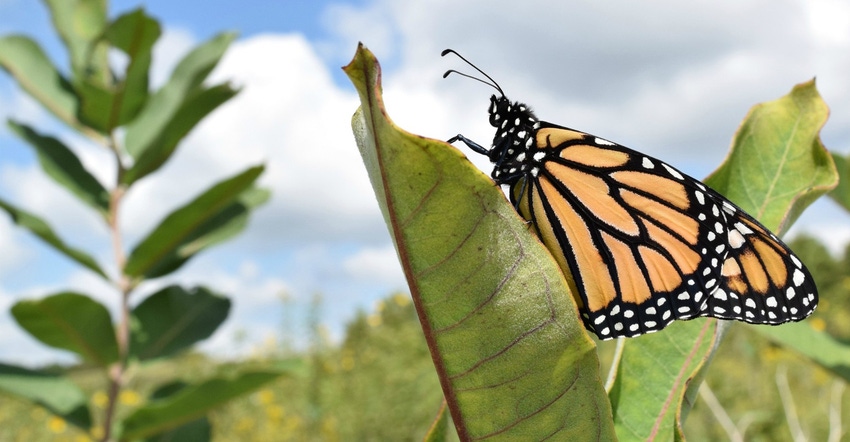
Suppliers in Iowa who sell cover crop seed say they can hardly keep up with requests for pollinator seed mixes. These are a blend of native grasses and wildflowers that provide habitat for bees, butterflies, hummingbirds and other important pollinators.
A collaborative effort, the Iowa Monarch Conservation Consortium, is working to increase the number of acres of habitat for monarch butterflies and other pollinators in the state. The consortium released an updated Iowa Monarch Conservation Strategy in March. They seek to establish 480,000 to 830,000 acres of monarch habitat in Iowa by 2038. Monarchs migrate to and from the Midwest during the warmer months.
Iowa is an important habitat zone for monarch butterflies, especially in summer, when they breed and feed on milkweeds and other pollinator-friendly plants and flowers.
“Monarchs and other pollinator insects are important for pollinating agricultural crops, as well as flowers and ornamental plants,” says Dana Schweitzer, program coordinator for the consortium, based at Iowa State University. “The population of monarchs has declined significantly during the past 20 years.”
ISU Extension and other consortium members have been holding meetings across the state this year, sharing ideas on how landowners can increase monarch habitat — on farmland as well as urban and suburban land, rights-of-way and other public lands. “We’re excited to partner with Pheasants Forever and NRCS to provide resources and information about monarch habitat demonstration projects around the state,” Schweitzer says.
ISU Extension will host a monarch and pollinator field day on Aug. 21 at the Prairie Ridge Care Center in Orange City. The program will run from 2:30 to 3:30 p.m. and includes a field tour of the monarch and pollinator habitat planted at Prairie Ridge Care Center at 1005 Seventh St. NE. It is designed for landowners and families who want to learn more about planting pollinator habitat. There is no cost to attend the event, but you are asked to RSVP to the ISU Extension Sioux County office via email at [email protected] or phone 712-737-4230. Refreshments and on-site parking will be provided.
Learn how to establish pollinator habitat
Seth Appelgate, ag specialist with ISU, will speak on establishing monarch and pollinator habitat. Information about habitat assistance and cost-share programs will be provided by Troy Davelaar, biologist with Pheasants Forever.
“The monarch butterfly population east of the Rocky Mountains has declined over the past 20 years, and Iowa can play a big role in their recovery,” Appelgate says. “Monarch larvae feed exclusively on milkweed, while adult monarchs depend on nectar plants as food sources. Iowa State has established habitat demonstration projects across the state and is collecting data from these sites to develop habitat establishment best management practices and to help researchers understand how monarchs use the new habitat.”
ISU researchers are studying the best methods for establishing pollinator habitat on non-productive land, such as roadside ditches and unused grassy spots on acreages. Livestock farmers are planting pollinator habitat next to hog barns. In addition, utility companies are planting habitat on utility rights-of-way. Iowa ethanol plants have joined together to plant “monarch fueling stations” next to their facilities.
Studies show smaller plots of habitat broadly spaced throughout the landscape may be more beneficial to monarchs, as they flutter from one location to the next, rather than large tracts of land with a lot of area in between.
Monarchs on the Move youth program
For youth attending the Aug. 21 field day, Monarchs on the Move will offer hands-on activities. The 4-H program was created through ISU Extension with activities that focus on monarch biology, habitat and ways to increase habitat for monarch butterflies and pollinators. Youngsters can experience life as a monarch caterpillar on a milkweed plant with a life-sized milkweed model and explore satellite images to look for opportunities to plant habitat.
For more information, visit Monarch Conservation Consortium and Monarchs on the Move program.
About the Author(s)
You May Also Like




